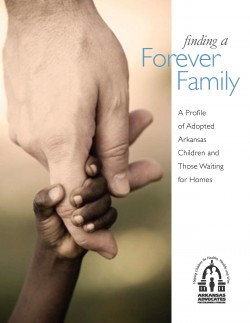
More than 400 children in Arkansas are waiting to find an adoptive family. They are in the custody of the Arkansas Department of Human Services (DHS) and their parents’ rights have been terminated because they were unable or unwilling to care for them. Many of these children wait a long time for a family, especially older children, minorities and those who have physical, mental, or emotional difficulties. All of these children deserve loving, “forever” families.
In this report, we see where the system is working best and where it needs improvement by examining which children have been adopted and the conditions under which they were adopted. Using data from DHS Department of Children and Family Services (DCFS), we examine the characteristics of children who have been adopted in the past and those who are waiting to be adopted. Between 2002 and 2009, more than 3,200 Arkansas children were adopted from DHS custody. Another 425 children are currently waiting in the foster care system.
What do we know about these children?
- It took an average of 30 months for them to be adopted after entering the system. In the life of a child, 2.5 years is a long time to be without a family.
- The time it takes for children to be adopted after entering foster care varied greatly by geography. Children in Northwest Arkansas were adopted within an average of 25.3 months while children in the Delta waited an average of 51.42 months.
- Minority children, older children and children with special needs waited longer to be adopted than other children.
- Children still waiting for adoption tend to be older, in larger sibling groups, more likely to be boys, and are more likely to be multiracial.
Fortunately, there are many promising steps that the state and supporters can take to help Arkansas children in foster care find their forever homes faster. These include better coordination to ensure adoptive families are ready for children as soon as they’re available for adoption, mobilizing local groups to help children become adopted faster, and focusing efforts on older children.
